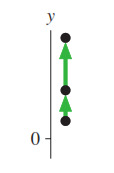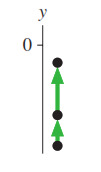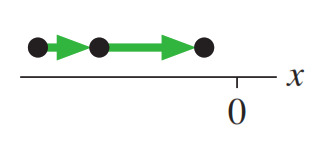#Physics for Scientists and Engineers 3rd Edition by Randall Knight Solution Manual
Explore tagged Tumblr posts
Photo

Does the object represented in FigUre Q1.5 have a positive or negative value of ay? Explain. Does the object represented in Figure Q1.5
#acceleration from motion diagram#motion diagrams#particle diagram#physics for scientists and engineers#Physics for Scientists and Engineers 3rd Edition by Randall Knight Solution Manual#Physics for Scientists and Engineers: A Strategic Approach with Modern Physics by Randall D. Knight Solution Guides#Physics PDF solutions#Physics Solution Manual#Physics Solutions#position#positive or negative acceleration#velocity diagram
1 note
·
View note
Text
Physics for Scientists and Engineers 3rd Edition by Randall Knight, Chapter 1 Conceptual Question 8
Determine the signs (positive or negative) of the position, velocity, and acceleration for the particle in Figure Q1.8.

Figure Q1.8 (more…)
View On WordPress
#acceleration from motion diagram#motion diagrams#particle diagram#physics for scientists and engineers#Physics for Scientists and Engineers 3rd Edition by Randall Knight Solution Manual#Physics for Scientists and Engineers: A Strategic Approach with Modern Physics by Randall D. Knight Solution Guides#Physics PDF solutions#Physics Solution Manual#Physics Solutions#position#positive or negative acceleration#signs of acceleration#signs of position#signs of velocity#velocity diagram
0 notes
Text
Physics for Scientists and Engineers 3rd Edition by Randall Knight, Chapter 1 Conceptual Question 7
Determine the signs (positive or negative) of the position, velocity, and acceleration for the particle in Figure Q1.7.

Figure Q1.7 (more…)
View On WordPress
#acceleration from motion diagram#motion diagrams#particle diagram#physics for scientists and engineers#Physics for Scientists and Engineers 3rd Edition by Randall Knight Solution Manual#Physics for Scientists and Engineers: A Strategic Approach with Modern Physics by Randall D. Knight Solution Guides#Physics PDF solutions#Physics Solution Manual#Physics Solutions#position#positive or negative acceleration#signs of acceleration#signs of position#signs of velocity#velocity diagram
0 notes
Text
Physics for Scientists and Engineers 3rd Edition by Randall Knight, Chapter 1 Conceptual Question 6
Determine the signs (positive or negative) of the position, velocity, and acceleration for the particle in Figure Q1.6.

Figure Q1.6 (more…)
View On WordPress
#acceleration from motion diagram#motion diagrams#particle diagram#physics for scientists and engineers#Physics for Scientists and Engineers 3rd Edition by Randall Knight Solution Manual#Physics for Scientists and Engineers: A Strategic Approach with Modern Physics by Randall D. Knight Solution Guides#Physics PDF solutions#Physics Solution Manual#Physics Solutions#position#positive or negative acceleration#signs of acceleration#signs of position#signs of velocity#velocity diagram
0 notes
Photo

Physics for Scientists and Engineers 3rd Edition by Randall Knight, Chapter 1 Conceptual Question 4 Does the object represented in Figure Q1.4 have a positive or negative value of a_x? Explain.
#acceleration from motion diagram#motion diagrams#particle diagram#physics for scientists and engineers#Physics for Scientists and Engineers 3rd Edition by Randall Knight Solution Manual#Physics for Scientists and Engineers: A Strategic Approach with Modern Physics by Randall D. Knight Solution Guides#Physics PDF solutions#Physics Solution Manual#Physics Solutions#position#positive or negative acceleration#velocity diagram
0 notes
Photo

Physics for Scientists and Engineers 3rd Edition by Randall Knight, Chapter 1 Conceptual Question 3 Is the particle in FIGURE Q1.3 speeding up? Slowing down? Or can you tell? Explain. Solution:
#motion diagrams#particle diagram#physics for scientists and engineers#Physics for Scientists and Engineers 3rd Edition by Randall Knight Solution Manual#Physics for Scientists and Engineers: A Strategic Approach with Modern Physics by Randall D. Knight Solution Guides#Physics PDF solutions#Physics Solution Manual#Physics Solutions#position#speeding up or slowing down
0 notes
Text
Physics for Scientists and Engineers 3rd Edition by Randall Knight, Chapter 1 Conceptual Question 2
How many significant figures does each of the following numbers have? a) 310 b) 0.00310 c) 1.031 d) 3.10(10)^5
How many significant figures does each of the following numbers have? a) 310 b) 0.00310 c) 1.031 d) Solution:
Part a
Zeroes before the decimal point merely locate the decimal point and are not significant. Thus, 310 has 2 significant figures.
Part b
Trailing zeros after the decimal point are significant because they indicate increased precision. Therefore, 0.00310 has 3…
View On WordPress
#Physics for Scientists and Engineers 3rd Edition by Randall Knight Solution Manual#Physics for Scientists and Engineers: A Strategic Approach with Modern Physics by Randall D. Knight Solution Guides#Physics PDF solutions#Physics Solution Manual#Physics Solutions#Scientific Notation
0 notes